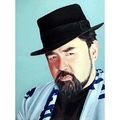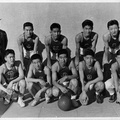It is quite difficult for the viewer of Ray Yoshida’s wide ranging and yet interconnected work not to wonder if his paintings and collages are sending messages in code, through and with the myriad images he has chosen and depicted.
Many of his works provoke a “what is this saying” response, as if they are experiments in image language and semantics. Their muted and striking color choices and schemes create a beguiling sense of familiarity, dissonance, and discord.
Many times I have found myself reckoning, wondering, and reacting, or at least hoping that the images could be deciphered. As my familiarity with his work increased and I had more time to consider and reconsider it, my wonder and questions slowed, then ceased to be so formal, ceased to be epistemic, ceased to be analytical. I began to grasp the works as playful, in a challenging way, as amusing and dissembling, as not representational, but as subversive and implosive and frequently amusing, if not funny.
Yoshida was born in Hawaii on October 3, 1930, and where he passed away on January 10, 2009. His grandparents and his father were born and raised in Japan. His mother, who was also ethnic Japanese, was from Hawaii. He attended the University of Hawaii for two years and then was drafted into the army. After returning to Hawaii, he was persuaded by a sister who was a nurse in Chicago, to join her there and pursue his studies. He did join her and received a BFA from the School of the Art Institute of Chicago (SAIC) in 1953. From there he went to the University of Syracuse, earned an MFA, and by 1959 returned to Chicago to teach at SAIC.
His work was in a group show as early as 1953 in Honolulu, and in 1960 he had a solo exhibition at Rockford College, Rockford, IL. 1969 was a significant year for his art—and for what became known as the Chicago Imagists. Artist and curator Don Baum included his work in Don Baum Sez “Chicago Needs Famous Artists,” at the Museum of Contemporary Art. He also had work in The Spirit of the Comics, installed at the Institute of Contemporary Art at the University of Pennsylvania. This exhibit opened October 1, 1969 and had a national and Canadian tour into 1971.
His Comic Book Specimens which used drawings cut from comic strips and books, began as early as 1962 and was only one of many series of collages and paintings; earlier he painted geometric forms. He also made Lucite box collages; then worked with figures in an abstract context; made paintings inspired by comics; by robed figures; rock collages; and continued in this fashion past his retirement from SAIC.
Yoshida has many connections to the Chicago Imagists. Some of them were his students. His work is and is not, however, representative of the Imagists. In my opinion, it is more muted, more evasive, more schematic, less pointed, less garish. Yoshida’s colors are frequently cool-to-cold, with underlying warmth; they attain a kind of glow, though that glow has no more presence than a low wattage light bulb in an already lit space. That glow often relies on blues, though in many cases, he also relies on reds, oranges, siennas, and browns. The images and glow of his paintings can induce a menacing, disturbing, and indeterminate response. This is especially true of the robed figures. Many of his images and paintings have unsettling sexual aspects and what I take to be phallic jokes, which are impudent rather than rude, crass, or vulgar. They are also amusing and sometimes funny, in sly, dead pan ways.
Even in the collages, where there is space separating the images, Yoshida’s works present a prolix visual field, composed of borrowed and familiar images. Sometimes the images and colors have a strange and unsettling sense of movement, of dance. Occasionally this is joyous and frivolous, though just as often it is disturbing. I am most moved, and perturbed by the visual overload on display. Yoshida envisioned a present saturated by images that more resembles our present than the 1960s when he first created the Comic Book Specimens and other related works. Experiencing his collages and paintings in an exhibition is like being placed in a filmstrip that is designed by Chris Ware executed by Chris Marker and refined by Terry Gilliam and inspired by Ivan Albright.
To see Ray Yoshida’s artworks >> (Art Institute of Chicago)
© 2013 Paul Yamada





